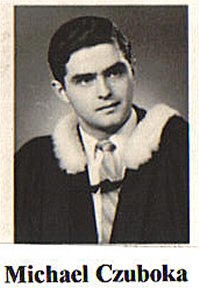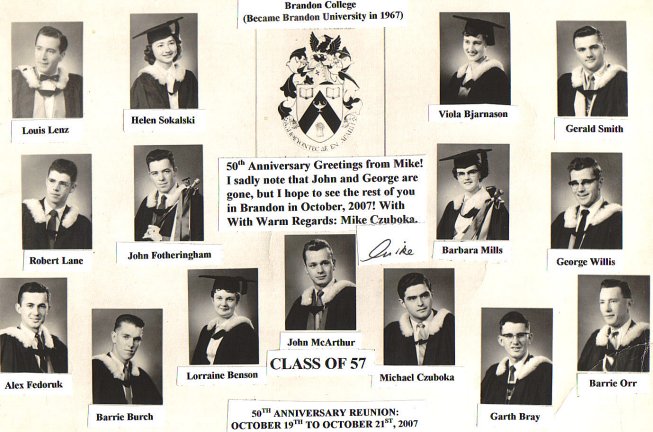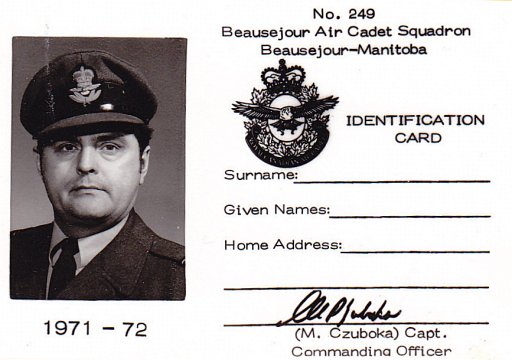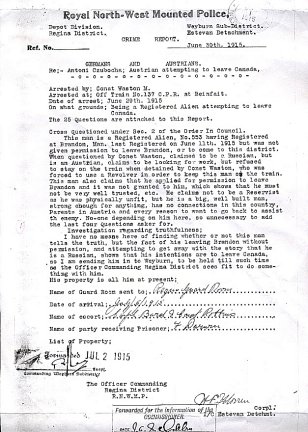THE RIVERS CONNECTION
My father, who, along with thousands of other Ukrainians, was unjustly
interred by Canadian authorities during WWI, managed to secure employment
as a section labourer with the Canadian National Railways during the 1930s.
We moved to Rivers in 1937 and I entered Grade 1 at the Rivers Consolitated
School that same year. Rivers was an important divisional point on the
CNR and most of its residents were railway employees and their families.
WWII broke out in 1939 and construction on an air base at Rivers began
shortly afterwards.
During the war years the airport at Rivers was a part of the British
Commonwealth Air Training Plan and its facilities were used primarily
by Avro Ansons for the purpose of training navigators. I remember the drone
of airplane engines almost every evening during the early 1940s. It was
an exciting time. Crashes were frequent. Airman from Britain, Australia
and New Zealand who were killed in these crashes were buried in the Rivers
cemetery.
After the war ended Rivers continued as a military base and was eventually
called the "Canadian Joint Air Training Centre" or "CJATC" because all
three services trained there. All military parachute training in Canada
at that time took place in Rivers and Shilo. The base's recreational facilities,
with a large gymnasium, bowling alley and swimming pool were superior to
those we had in the town of Rivers. Brooke School at the base, beginning
in the early 1950's, enrolled students from the town, including brother
Bill, as well as from CJATC. I was impressed and envious of these facilities.
As a young boy, I greatly admired all of the soldiers, sailors and airmen
that I saw, and I seriously considered a military career. An opportunity
opened when the Korean War broke out in 1950. I quickly enlisted.
After I returned from serving with 2 PPCLI in the Korean War, I completed
a parachute course at Rivers and Shilo. I was then stationed at Calgary.
During the last year of my army service, during 1953-54, I was posted to
the Airborne School at Rivers. One of my jobs at the Airborne School was
working with the Personnel Officer. The Chief of the Defence Staff was
concerned because of the high failure rate of people taking parachute training,
also called "the jump course". I gave a modified version of the Minnesota
Multiphasic Personality test to incoming parachute trainees to see if it
could identify potential failures. Eureka! After administering the test
to a large number of parachute trainees, I discovered that one item was
significant: "I am afraid of heights". People who failed the jump course
were afraid of heights! I don't know how, or if, this discovery was ever
used, because in the fall of 1954 I left the army and enrolled at Brandon
College.
MY MILITARY CAREER
BEFORE AND DURING THE BATTLE OF KAPYONG
A PERSONAL MEMOIR
by Michael Czuboka
Originally published in the 2008 edition
of The Patricia magazine
PART I: JOINING THE SPECIAL FORCE FOR KOREA:
I was born in Brandon, Manitoba to Ukrainian immigrant parents in 1931.
My father, a CN section labourer, like thousands of other Ukrainians, was
unjustly interned by Canadian authorities during WWI simply because he
was classified as a citizen of the Austrian-Hungarian Empire, an enemy
of Britain and Canada during that world war. The Ukrainians, ironically,
had come to Canada to gain freedom from an oppressive and foreign regime.
I believe that my father wanted his three sons to be good Canadians, but
that he was probably never able to overcome his belief that he was an unwanted
foreigner in Canada. If he had lived long enough, he would certainly have
been proud of the fact that all three of his sons, Walter, Bill and Mike,
would eventually became commissioned officers in the Canadian Forces. It
is certainly true that I, as a young man, needed to prove that I was a
good Canadian and that this was one of the reasons I joined the Canadian
Army in 1950.
In the summer of 1950 I was an 18 year old construction labourer living
in Rivers, Manitoba, a CN Railway town, and working on renovation projects
at the nearby Canadian Joint Air Training Centre. I had earlier graduated
with a Grade 12 "senior matriculation" standing, but jobs were scarce and
I considered myself fortunate to have employment of any kind. I wanted
to further my studies with a university degree in either arts or science,
but neither my parents nor I had any money for that purpose.
I had grown up in Rivers and I was impressed by the young soldiers,
sailors and airmen who served at CJATC, and especially those who wore wings.
While attending high school in Rivers I became an air cadet, gained military
experience by attending summer camps at air force bases, and was promoted
to sergeant, the highest cadet rank in #320 Rivers Squadron. My older brother
Walter, as a Flying Officer with the Royal Canadian Air Force, had completed
52 air missions over the Atlantic Ocean and Europe during WWII and I admired
him greatly. I had been too young to serve in the war and I felt that I
had been left out of a great and exciting historical event. A military
career greatly appealed to me and the Korean War would eventually give
me a chance for the kind of an adventure that I had missed during WWII
because of my youth.
The Korean War broke out in June, 1950, and later in that summer the
Canadian Government announced that it would recruit a "Special Force" for
the purpose of serving in the war. What was especially appealing to many
recruits about this force was its limited 18 month period of service. In
those days, those who enlisted in the Canadian Forces were usually required
to enlist for at least three years. Moreover, it was practically impossible
to get out earlier than three years. It was almost like being in the French
Foreign Legion. You signed your life and freedom away. The Canadian Army,
in those days, was lacking in sensitivity and human relations skills. Soldiers
did not have any "rights" as we know them today. You were required to obey
all orders without questions of any kind. It was a joke but also a reality
when lieutenants, or sergeants, or even corporals said: "I need three volunteers
to go on a dangerous patrol and I have decided that the volunteers will
be you, you and you".
In early August, 1950, shortly after the Special Force enlistments began
at recruiting depots across Canada, I decided to travel from Rivers to
Fort Osborne in Winnipeg, a distance of about 125 miles, in order to join
up. But how would I get there? My funds were limited. Fortunately, I knew
a CN Railway fireman and he smuggled me into a caboose at the end of a
freight train going to Winnipeg. I arrived full of enthusiasm but was initially
rejected because of my age.
"How old are you?" the recruiting officer asked skeptically. "You look
like you are about 15!"
" I know that I look younger, but I am 18 years old" I truthfully
replied.
"That's too young to be in the Special Force" he said. "You have to
be at least 19. Go home and come again when you are 19".
I did go back to Rivers but I returned to Fort Osborne about two weeks
later and hesitatingly, and with considerable trepidation, told another
recruiting officer that I was 19 years old. He did not look at me too closely
and did not seem to care. I was a warm body and the army was not too particular.
I was never asked for a birth certificate or documentation of any kind,
either then or ever. I aged by one year instantaneously and was immediately
enrolled, at my request, into the Princess Patricia's Canadian Light Infantry.
I wanted adventure, and the infantry was the place to get it.
On August 22, 1950, at about the time I was scheduled to travel by train
to the PPCLI in Calgary, Canada's railway workers went on strike. The problem
was solved by the Royal Canadian Air Force. I, along with other recruits
from Winnipeg's Osborne Barracks, were loaded onto C-47 Dakota aircraft
and flown to Calgary. We arrived, a lot of us sick and vomiting because
of a bumpy ride on a hot August day, and were immediately housed at Currie
Barracks. Unfortunately, the Army was not ready to receive us and we languished
for many days in our civilian clothing. Finally, in about mid-September,
we were equipped with WWII vintage uniforms, webbing, kit bags, boots,
mess tins, and .303 Lee Enfield rifles. Shortly afterwards we were shipped
to Wainwright, Alberta, to undergo basic training. Our training was under
the command of Lieutenant-Colonel "Big Jim" Stone, the CO of 2 PPCLI and
Brigadier John Rockingham, commander of the 25th Infantry Brigade. Both
officers had had served with distinction in WWII. In fact, most of our
senior non-commissioned and commissioned officers were veterans of the
war that had ended only about five years earlier.
PART II : TRAINING FOR THE KOREAN WAR AND SAILING TO
KOREA:
Camp Wainwright was located on the sandy site of the former 25 square
mile Buffalo National Park in central Alberta. It served as an artillery,
armoured and infantry training area during WWII , and briefly as a German
prisoner-of-war camp at the end of the war. Its facilities were expanded
considerably at the beginning of the Korean War, but in November, 1950,
it was decided that the entire 25th Canadian Brigade would be moved to
Fort Lewis, Washington because of the better facilities at that location.
It was apparently cheaper to rent from the United States than to spend
a lot of money on Wainwright. We did not complain. The idea of living and
training near Seattle, a large American city was very appealing to the
men of all ranks. Seattle, we reasoned, probably contained a lot of beautiful
women who were anxious to consort with handsome and heroic Canadian soldiers.
In late November, 1950 several trains began transporting soldiers from
my regiment, the PPCLI and other units, from Wainwright to Fort Lewis.
We were loaded onto old wooden colonial railway coaches. These ancient
and fragile vehicles had originally been used to haul immigrants, like
my parents, to the Canadian Prairies. Tragedy stuck on November 21, 1950
when two trains, including a troop train, collided at Canoe River in British
Columbia, killing 21 people, including 17 soldiers from the Royal Canadian
Horse Artillery. Investigators later decided that these deaths were caused
primarily by the weaknesses of the wooden coaches in which we were travelling.
It was alleged, by some, that the Government and military authorities were
negligent because of their decision to transport soldiers in these ancient
and dangerous conveyances. The investigators noted that none of the civilians
who were riding in modern and strong steel coaches died in this collision
and concluded that the soldiers had died as a result of government cost-cutting.
Shortly after our arrival at Fort Lewis the Canadian Government decided
that only the 2nd Battalion, Princess Patricia's Canadian Light Infantry
would be sent to Korea on an immediate basis. The communist forces of North
Korea had been pushed back to the Yalu River on the border with China and
General Douglas MacArthur, the United Nations commander, had declared that
the war would be over by Christmas. It appeared that 2 PPCLI was being
sent as a token occupation force and that the rest of the brigade would
probably not follow.
When I arrived at Fort Lewis on November 21, 1950, I was a rifleman
in the PPCLI. One day a number of us were called to a special parade and
we were told that we were being re-assigned. Most were sent to rifle companies,
but when my name was called out I was told that I was now a member of 2
PPCLI's 81 mm. mortar platoon. "Mortar platoon?" I asked myself. "What
is a mortar platoon and what will I be doing?" I vaguely remembered seeing
mortars in WWII movie newsreels, but I knew next to nothing about them.
I would not see any 81 mm. mortars until after we arrived in Korea. I wondered
why and how I was assigned to the mortar platoon, and I concluded that
it was simply an arbitrary decision and not for any particular reason.
That's how the army worked in those days.
On November 25th, after only four days at Fort Lewis, we were shipped
to Port Angeles and loaded onto the Private J.P. Martinez, a rusting "liberty
ship" from WWII. These vessels had been welded together for temporary use
and did not appear to be very seaworthy. The facilities were crude and
the food was almost inedible. I still shudder over the memory of seeing
large black cooks sweating into the soup and food that they prepared in
the galleys for our consumption. We had coloured meal cards and ate at
badly coordinated times to announcements on loudspeakers such as:
"Yellow cards will chow now; will chow now." The weather was some of the
worst in memory and even the ship's crew were seasick. I spend the first
week in my bunk flat on my back and next to my rifle. The bunks were six
deep and jammed together in the hold. The odour of unwashed bodies and
feet was almost unbearable. Moreover, we learned, about half way across
the stormy and badly-named Pacific, that the Chinese had entered Korea
in large numbers and that the United Nations forces were in retreat. We
were going to a full scale war and not occupation duties as previously
announced. After about 23 days, including brief stopovers in Hawaii and
Japan, we arrived at Pusan in South Korea. We disembarked to the sounds
of a welcoming U.S. military band. We were in the "land of the morning
calm", the nickname sometimes given to Korea. It was December 18th, and
we had arrived just in time to prepare for Christmas.
PART III: KOREA FROM DECEMBER, 1950 T0 APRIL, 1951:
Pusan was a collection of huts and ramshackle buildings that housed
tens of thousands of refugees. A pungent odour of charcoal, fish and human
excrement filled our nostrils. Fortunately, we did not stay long. Big Jim
Stone advised General Walker, his American superior, that we were not ready
to fight and needed about six weeks of training. General Walker reluctantly
agreed, but not until after Stone produced formal instructions that he
had received from Ottawa.
We were moved to an orchard area near Miryang, about 50 kms. north of
Pusan, and our training there lasted until mid-February. We also spent
some time in the neighbouring hills hunting guerillas. It was at Miryang
that I first learned how to use an 81 mm. mortar. I was assigned to a "number
two" position. My responsibility was to feed "bombs", or "shells" into
my mortar. Feeding bombs into the barrel of a mortar required good coordination
because a "double feed" into a barrel would cause an explosion and wipe
out the whole mortar crew, as happened on more than one occasion. Our platoon
had six half-tracks with a three man mortar crew each. Each half-track
had one .50 caliber and one .30 caliber machine gun mounted. We carried
several hundreds bombs, most of which were of the high explosive variety,
and a few that were made of phosphorus and used for creating smoke. Range
was determined by an elevation-finding sight on the side of the mortar.
Small packages of explosives called "charges" were added or removed at
the end of each bomb for the purpose of increasing or decreasing distances
of delivery. In later years I learned that mortars are considered by military
experts to be extremely effective infantry weapons.
What I remember most about Miryang is the clean, relatively odourless
air, the cozy sleeping bags, folding cots and tents where we slept, and
the hot food. It was in an orchard area and human excrement was not spread
on the fields and rice paddies as in most parts of Korea. After leaving
Miryang, and for the rest of my tour in Korea, I slept in a slit trench
or simply on the ground and ate canned American "C" rations most of the
time. More than once, during the cold Korean winter, I woke up only to
find myself covered in snow.
The first year in Korea was one of rapid movement. We moved frequently
from February to April. It was not until the fall of 1951 that both sides
began to prepare relatively permanent defensive trenches and bunkers that
were reminiscent of those that were used in WWI. During most of the period
between mid-February and mid-April , the Chinese gradually retreated northwards.
Seoul was retaken in mid-March and the UN forces, including our battalion,
began to push across the 38th parallel and into North Korea. During these
first few weeks of combat 2 PPCLI had 14 killed and 42 wounded. Casualties
were light compared to those suffered by Canadians in WWI and WWII, but
we were certainly in a real war and not a police action. My own problems
were relatively minor.
On one occasion when I was feeding bombs into our mortar on a "rapid
fire basis", a "delayed action" took place. One of the bombs did not emerge
from the barrel as was anticipated. I instinctively lifted my head next
to the barrel, in keeping with normal procedure, and I was greeted with
a loud explosion as the faulty projectile exited. Blood immediately came
out of both ears. As a result, I suffered a permanent hearing disability.
In early March, when it was still very cold, I was stricken by a serious
case of dysentery. I lost total control of my bowel movements. I became
very sick and was loaded onto an Indian Jeep Ambulance and was transported,
along with two seriously wounded Chinese soldiers, to an American MASH
hospital. I still remember the groans and occasional screams of my Chinese
companions during our bumpy ride. I remained at the MASH hospital for about
one week. I was visited only once in the hospital by an obviously inebriated
Canadian sergeant who thought that I had been wounded in action. When the
sergeant found out that I had dysentery and not a wound, he quickly terminated
his visit. As previously mentioned, the army in the 1950's was not known
for its sensitivity.
I was also infected with malaria in Korea but it did not surface until
the summer of 1952 when I was taking a course at Camp Borden in Ontario.
Flash forward about a year. It took the doctors at Camp Borden Hospital
several days to diagnose my illness. My temperature rose rapidly to about
106 degrees and I became delirious. Two young and attractive female lieutenant
nurses rubbed my mostly naked body with alcohol to bring my soaring temperature
down. I was a shy corporal at the time, but I was having hallucinations
and I mischievously asked: "You are really enjoying this, aren't you? Fortunately,
they chose to ignore my remark. Corporals, in those days, were expected
to always speak to lieutenants in respectful terms.
Flash back to Korea. In the middle of February, 1951, our battalion
was loaded onto trucks and half-tracks at Miryang in preparation for our
move to the front, at that time about 200 kms to the north. I remember
the cloudy skies, snow-covered valleys and mountains, icy and winding roads
and the bitter sub-zero cold. It took us about two days to get from Miryang
to the front. Very cold Arctic winds from nearby Siberia often descend
down the Korean peninsula, and they certainly came frequently in the winter
of 1950-51.
As we arrived on our half-tracks at the Korean village of Kudun, near
the front line, we were suddenly confronted with a scene of horror. I had
never seen a dead body until that day, but now something like 68 black
and mostly naked American bodies were scattered all around us. They had
been bayonetted and shot by the Chinese, and their weapons and clothing
had been removed. They were frozen solid and looked like black marble statues.
Some were magnificent physical specimens and I remember feeling overwhelmed
with pity over their horrible fate. We were later told that this had been
a black infantry company. Some had their ring fingers cut off, and their
winter clothing, sleeping bags, boots and weapons had been removed. The
Chinese coveted American clothing and weapons and took them whenever they
could. Apparently these black American soldiers, led by white officers,
had posted a single sentry on the previous evening and had not dug slit
trenches. Although only about 68 bodies were counted on that day, it was
subsequently reported that more than 200 had been killed. In later years
I read a report by the Chinese Communist Forces "CCF" 116th Division which
claimed that two companies of the U.S. 23rd Infantry Regiment had been
annihilated at dawn on February 14, 1951. American infantry companies do
hold about 100 soldiers, so if two companies were wiped out, 200 dead seems
like a reasonable estimate. The Chinese had a habit of removing dead bodies,
and especially their own.
I was shocked by this bloody spectacle and ate very little for the next
several days. I knew that we were in a war, but I was not prepared for
such a sudden and violent introduction. I noticed that my three companions
on our half-track were also taking it badly. All had turned very pale and
silent. Our commanding officer, Lieutenant-Colonel Jim Stone, on the other
hand, considered this to an important lesson for all of us. We would, in
future, never be allowed to use sleeping bags in the front line. And needless
to say, it became apparent that a strong contingent of sentries was always
needed, and especially at dawn, the time when the Chinese preferred to
attack.
PART IV: THE BATTLE OF KAPYONG:
The Chinese Spring Offensive of April, 1951, turned out to be the greatest
battle of the Korean War. The introduction to Hub Gray's excellent book
Beyond the Danger Close states that a part of this offensive began immediately
north of Kapyong when "10,000 men of the South Korean 6th Division panicked
and fled running south, leaving a 16 km gap in the front line. Two Chinese
divisions, with 20,000 men blitzed southward 40 km in 36 hours to Kapyong,
where the badly outnumbered 1,700 men of 2 PPCLI and 3 RAR were ordered
to hold the line." According to Gray, 2 PPCLI was considerably under strength
at this time, with only about 700 soldiers in the front line rather than
a full battalion component of 940.
In the meantime, a few miles further west, the British Gloucester Battalion
heroically held its ground and was virtually wiped out. Most of the Gloucesters
were either killed or captured and only about 56 out of about 900 survived
the battle. Our fate could easily have been the same. Of course, we we
did know any of these details at that time. We were simply told that the
Chinese were attacking in large numbers and that we would have to stop
them.
In late April we were in a reserve position in the Kapyong area. Our
activities included cleaning weapons, undergoing kit inspections and replenishing
our supplies of ammunition and other supplies. We appreciated getting periods
of uninterrupted and peaceful sleep. Japanese Asahi beer was available
and eagerly consumed. For the first time in several weeks we enjoyed hot
meals. American "C" rations, which we used in front line positions, consisted
of predictable and boring cans of meat, vegetables and fruit. Late April
also brought spring to Korea. The weather was warm and pleasant, and I
have often wondered if it was at this time that a malaria-infected mosquito
bit me.
Unfortunately, our respite was quickly and rudely interrupted. Our commanding
officer, Big Jim Stone, was suddenly ordered to take 2 PPCLI to positions
on Hill 677 north of the Village of Kapyong. At the same time, the 3rd
Battalion of the Royal Australian Regiment was instructed to occupy Hill
504, a lower feature located immediately across from Hill 677. The valley
below was a critical part of main route to the South Korean capital of
Seoul, and the Chinese understood that they needed to control Hills 677
and 504 to allow a safe passage southward.
Lieutenant-Colonel Stone demonstrated his competence and experience
as a veteran of WWII by taking his company commanders on a reconnaissance
of Hill 677. Captain Lloyd Hill, our 81 mm. Mortar Platoon commander, also
accompanied this group. We were later told that Stone and his officers
studied the approaches that the Chinese would likely use during their attack.
Companies and platoons were to be deployed, as much as possible, in mutually
supporting positions. The advantage of Hill 677 was that it contained many
very steep approaches, which meant that the attackers would often have
to monkey run upwards to get at us. In those days the mountains of Korea
had very few trees and visibility was unrestricted. During visits to Kapyong
in 2003 and 2008, I was amazed at how Hill 677 and other Korean mountains
were now covered with thick forests. In April, 1951 the mountains were
mostly bare and the Chinese were especially vulnerable to grenades that
were rolled down towards them on the steep and visible slopes. To a large
extent, however, the defence of Hill 677 would depend upon artillery and
81 mm. mortar fire.
At first it looked as though we would not be able to get our half-tracks
and 81 mm. mortars to the top of Hill 677. Lieutenant Lorne Hurst, the
Pioneer Platoon commander, said that our half-tracks could not make it
up because of the very narrow track. Stone did not agree. According to
Hub Gray, Stone growled at Hurst and said: "Hurst, get the half-tracks
up that bloody hill!" No one ever questioned Stone's orders and Hurst quickly
complied. In retrospect, it can be concluded that the survival of the entire
battalion eventually depended, to a large extent, upon the 81 mm. Mortar
Platoon. Our supporting New Zealand and American artillery batteries were
also very important, but they were not as readily available as our mortars.
If the Mortar Platoon had not reached the top of Hill 677, it would probably
have been ineffective. If fact, if we had been left in the valley below
we would have been very vulnerable and likely would have been eliminated
by the Chinese very quickly. The Chinese were swarming all over the valley
below. As it turned out, our .50 caliber machine guns, deployed in a key
position on Hill 677 and commanded by Lieutenant Hub Gray, 2 IC of
the Mortar Platoon, would soon afterwards save the entire battalion from
total destruction.
I vividly recall our ascent with our heavily loaded half-tracks onto
Hill 677. It was getting dark and difficult to see anything. The route
consisted of a single narrow trail and wound dangerously back and forth
on its way to the summit. A slide into one of the deep ravines that bordered
the trail would have been disastrous. In some places the trail was blocked
with large stone outcrops and these had to be blown away with explosives.
Then, when we were almost at the top, one of our half-tracks broke down.
Stone threatened to push it into a nearby deep ravine. Fortunately a mechanic,
Bob Hoffman, arrived and revived the vehicle, which had apparently stopped
because of a dead battery.
Soon after arriving near the top of Hill 677 we unloaded our mortars
and set them up in small rice paddies. The ground was very hard and it
was impossible to dig down more than a few inches. However, the rice paddies,
with their stone walls, did offer some protection. My Number One Robbie
Roberts and I unloaded all of our mortar bombs in a pile close to our mortar.
I believe that we had about 2,000 mortar rounds on board. The whole Platoon
probably hauled about 12,000 mortar bombs to the top of Hill 677. I recall
that our half-track was so full that we were forced to sit haphazardly
on top of our heavy and volatile load. A single enemy shell or rocket could
easily have instantly detonated the whole load and blown all of us to kingdom
come. The other five mortars were set up similarly on rice paddies that
were close to ours. I dismounted the .30 caliber machine gun from our half-track,
as I usually did, in order to provide additional protection.
We were assigned "defensive fire" tasks. This allowed us to zero in
on the places where the Chinese were likely to attack. These targets were
called "Fox 1, Fox 2, Fox 3, and so on. When the Chinese later attacked
one or more of our rifle companies, we were given commands such as: "Rapid
Fire on Fox 1!"
During that first night hundreds of shadowy figures poured past us in
a southerly direction. We were told that these pathetic and usually weaponless
men were remnants of the Republic of Korea 6th Division, but we were not
sure. They could have been Chinese and North Koreans, and it is entirely
possible that some of them were indeed our enemies. Infiltration was a
common Communist tactic. These unwelcome intruders sometimes came to within
50 meters of our position and they made us extremely nervous.
Then we sat and waited. The Chinese decided to attack the Australians
on Hill 504 first and from our position high on Hill 677 we had a grandstand
view of the battle. Large numbers of Chinese soldiers were seen massing
in the valley below. Several American tanks were engaged in the battle
and one was knocked out. The Americans performed heroically even though
they were engulfed in large numbers of swarming Chinese. We later learned
that three of the American tank commanders were killed, and that the Australians
had 33 men killed and 58 wounded before they were overrun and forced to
withdraw from Hill 504. We were now alone and the Chinese turned their
attention in our direction.
The first Chinese attacks were against Baker Company. The company's
three platoons, with about 30 men each, were located approximately
200 meters to the northeast of our position. Because Baker overlooked the
valley, it is likely that the Chinese considered it to have the most important
strategic position. Able, Charlie and Dog companies were situated in higher
isolated positions to the north and west of Baker company and further away
from the river valley.
Although we were close to Baker company and could hear all of the violent
battle noises, we did not, at that time, know about all of the hand to
hand fighting that was taking place. Baker was being subjected to typical
CCF tactics, including bugles and human waves. We fired hundreds of mortar
rounds in support of the company, but we were not able to directly observe
the results of our action. But we were very effective. For instance, Lieutenant
Charles Petrie of Baker Company later recalled that on one occasion, as
dusk approached, 6 Platoon reported that the enemy was forming up in a
re-entrant and preparing for an attack. Our battalion 81 mm. mortars opened
fire on this force and "decimated it." Somewhat later 6 Platoon fixed bayonets
and forced the Chinese to retreat. Mortars are an extremely effective infantry
weapon but bayonets can also be very persuasive under the right circumstances.
The next two days and nights are a blur in my memory.We frequently fired
large volleys of mortar bombs in support of the rifle companies, and in
particular Baker and Dog. After trying and failing to dislodge Baker company,
the Chinese attacked Dog Company in large numbers. Lieutenant Mike Levy,
the commander of Dog Company's 12 Platoon, initiated a mortar and artillery
bombardment of his own position in order to stem the Chinese assaults.
We were told that we were surrounded and to expect an assault on our
position at any time. The attack that we were expecting came in the evening
of April 24th. We did not immediately notice their presence, but about
500 Chinese began to climb from the valley floor towards our location.
They were advancing quietly in our direction and they were not signaling
their approach with bugles and loud shouts as was their usual habit.
Lieutenant Hub Gray quickly took command of the eight .50 caliber machine
guns that were mounted on our half-tracks. Whether by a stroke of
genius, or as a result of sheer luck, these vehicles were located in a
very favourable position for the purpose of confronting the advancing enemy.
The machine guns were mounted on circular swivels and could be turned rapidly
to any direction. Gray handled this critical situation efficiently
and calmly. He waited until the leading formation of Chinese was only about
40 meters short of our position before giving the command to fire. The
eight .50 caliber machine guns opened up and began cutting a bloody swath
in the Communist ranks. I have often wondered by Hub Gray was never given
any kind of recognition for his very significant and important action.
At the very least, in my opinion, Gray should have been "mentioned in dispatches".
Unfortunately, military awards are not always given in a fair and objective
manner.
I was totally unaware of the approaching enemy until the moment that
Gray opened fire. We were, as usual, doing defensive fire tasks for the
rifle companies. As soon as we became aware of the Chinese in our vicinity,
we turned our mortars around about 180 degrees, raised them up to an almost
perpendicular angle, and began launching bombs on a rapid fire basis. Our
mortar bombs travelled only about 100 to 200 metres and began landing in
the midst of the Chinese.
It was a devastating slaughter. Jim Wall, a private in the Pioneer Platoon,
described the scene as follows in Beyond The Danger Close: "Approaching
our position in the dull light on night they looked like a bunch of ants
groping their way up the hill. It is frightening watching them slowly ascend,
and to realize that they are coming to kill us. When Gray orders the machine
guns to fire there are masses of the fallen, dead and wounded. Those left
standing grab what they can of their casualties and are running and tumbling
down the hill heading for the river." On the following day one of our men
went to the killing field, counted more than 100 dead Chinese, and then
stopped counting. It is highly likely that many other bodies had been dragged
away in keeping with Chinese practice.
The Battle of Kapyong ended very unexpectedly on April 25th and 26th.
By that time our Mortar Platoon was almost completely out of mortar bombs.
The rifle companies were also down to a few rounds of ammunition. Our food
and water was almost gone. We were in a desperate situation, but for some
reason the Communists did not continue with their attacks. However, the
trails and roads leading to and from Hill 677 still appeared to be occupied
by the enemy and Lieutenant-Colonel Stone radioed for help.
On the morning of April 25th several Flying Boxcars of the United States
Air Force suddenly roared over our position. Parachutes of various colours
opened up and drifted into our position. I eagerly helped to open up the
canisters and discovered that we had been supplied with mortar bombs, rifle
and machine gun ammunition, C rations and water. A minor miracle had taken
place. Robbie Roberts and I piled our fresh supply of bombs next to our
mortar. We were ready for action once more but everything remained strangely
silent. We were not called upon to fire again. On the 26th of April we
were ordered to re-load our half-tracks in preparation for a move from
Hill 677.
Our descent down Hill 677 was full of tension. We did not know if the
Chinese were still present. But nothing happened and we eventually reached
the main road in the river valley. A regimental combat team of the U.S.
Army had arrived to take our place. As we drove southward a powerful feeling
of relief surged through my mind and body. In spite of very difficult circumstances,
we had somehow survived.
But what were the reasons for our survival? I did not give this question
much thought in April, 1951, but in later years I concluded that the Chinese
had stopped their attacks at Kapyong because of their very heavy losses.
In particular, I believe that the machine guns firing in unison under Hub
Gray's command saved all of us at Kapyong. Their thunderous firepower decimated
the advancing Communist force of about 500. The Chinese, having already
suffered very heavy losses, must have felt that they had suddenly encountered
a powerful and well-armed enemy.
According to Hub Gray, 2 PPCLI had 35 wounded and 10 killed at Kapyong,
which is more than the official total of 23 wounded and 10 killed. Apparently
some casualties on Hill 677 took place before the actual battle began and
were therefore not officially counted. In any event, the 35 or 45 casualties
suffered by the Patricias during the Chinese April offensive was a lot
less than the approximately 850 by the Gloucesters or 91 by the Australians.
The United Nations forces, in total, had about 7,000 casualties.
I believe that our limited losses happened for the following reasons.
The Patricias were located on a high mountain with steep slopes that were
difficult to climb by the attackers. The battalion also had massive artillery
and mortar support that decimated the Chinese when they charged. Hub Gray
has calculated and observed that in addition to the Battalion's 81 mm mortars,
support was provided by 81 artillery pieces of the New Zealanders and Americans.
That extensive firepower was brought to bear on very small areas in front
of and on top of our companies and it killed thousands of Chinese. An additional
factor was that the Communists had advanced very quickly over a long distance
and that they were unable to bring up supplies and heavy weapons quickly
enough. Moreover, the air was controlled by the American Air Force which
attacked the Communists at every opportunity.
Lieutenant-Colonel John Bishop, in his very interesting book The King's
Bishop, provides an excellent observation in regard to the significance
of the Battle of Kapyong. Bishop served as a corporal with 2 PPCLI's Able
Company at Kapyong. He was later commissioned and retired after 35 years
of service in the Canadian Army. He points out in his book that if the
Patricias had not held at Kapyong, "the way would have been open for the
Chinese to drive the UN forces back to Seoul, and ultimately all the way
to Pusan and into the sea." He notes that when Kapyong, a relatively small
battle, is put into context, the stemming of the Chinese spring offensive
"entailed a massive loss of lives and material comparable in scale to many
of the engagements of WWI." The UN had about 7,000 casualties during April,
1951, but the Chinese total of about 70,000 was much more.
I remained in Korea until the fall of 1951 and then returned to Canada
for parachute training. Although the Battle of Kapyong took place more
than a half a century ago, I still vividly remember my involvement as a
19 year old private. Occasionally I dream that I am returning to Korea
and that the Communists have invaded once again. This dream never changes.
I am excited but not afraid because I know that I am going to survive and
return home. It is not an unpleasant dream. Of greater significance is
the fact that I still feel a strong attachment to my regiment. It is still,
even after many years, something like a family to me. "Once a Patricia,
always a Patricia" is certainly true in my case.

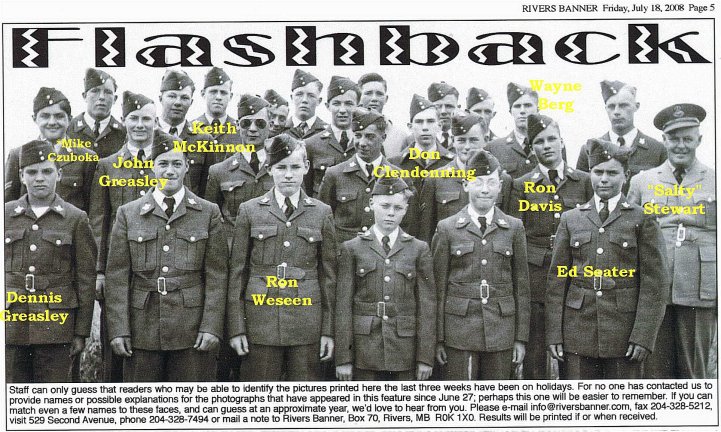

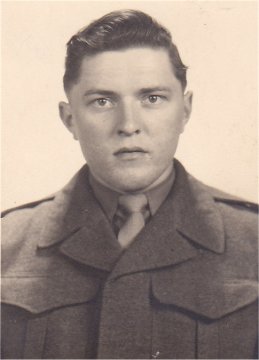 My brother, Bill
Czuboka, was born in Winnipeg in 1935. He grew up and went to elementary
school at Rivers. He attended Brooke High School at CJATC and has many
photos of this period in his life.
My brother, Bill
Czuboka, was born in Winnipeg in 1935. He grew up and went to elementary
school at Rivers. He attended Brooke High School at CJATC and has many
photos of this period in his life.
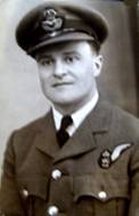 Brother
Walter Czuboka was a product of the British
Air Commonwealth Air Training Plan, although he did not train at Rivers.
He was a wireless airgunner.
He was near the top of his class and was promoted to a commission as soon
as he graduated. Walter completed 52 air missions over the Atlantic Ocean
and Europe during WWII.
Brother
Walter Czuboka was a product of the British
Air Commonwealth Air Training Plan, although he did not train at Rivers.
He was a wireless airgunner.
He was near the top of his class and was promoted to a commission as soon
as he graduated. Walter completed 52 air missions over the Atlantic Ocean
and Europe during WWII.
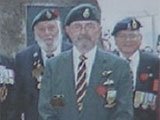 It's often referred
to as the forgotten war, but those who fought in Korea will never forget.
If he can't get the sound out of his head there's a good reason for that.
Firing mortar shells was Mike Czuboka's job during the Korean War in 1951.
That job is how he lost most of his hearing.
It's often referred
to as the forgotten war, but those who fought in Korea will never forget.
If he can't get the sound out of his head there's a good reason for that.
Firing mortar shells was Mike Czuboka's job during the Korean War in 1951.
That job is how he lost most of his hearing.
